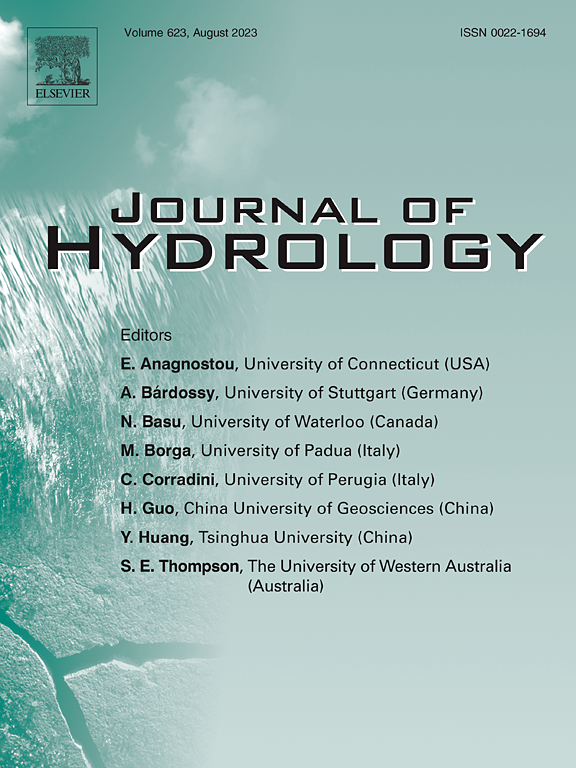Downscaling multilayer soil moisture using parameterized depth profiles associated with environmental factors
IF 5.9
1区 地球科学
Q1 ENGINEERING, CIVIL
引用次数: 0
Abstract
High-resolution multilayer soil moisture is valuable for water resources management, drought monitoring, and crop optimization. However, integrating process-based models into statistical downscaling methods to estimate multilayer soil moisture can increase both prediction uncertainty and computational complexity of parameterization. Here, three parameterized equations (Peak, Trough, and Balance) were proposed to quantify soil moisture profiles associated with environmental factors, and downscale multilayer soil moisture. Global (0–40 cm) and local (0–10, 10–20, and 20–40 cm) fitting strategies represented the vertical extent of environmental influences. Three machine learning models were employed to downscale satellite soil moisture and predict depth parameters, which were then used to generate sub-surface soil moisture. The results indicated that the local fitting strategy consistently outperformed the global strategy across all depths, reducing the mean absolute error (MAE) and root mean square error (RMSE) by 81.8 % and 80.4 %, and increasing the coefficient of determination (R2) by 22.5 %. Furthermore, local fitting revealed distinct nonlinear and linear patterns within the 0–20 cm and 20–40 cm intervals, respectively. The prediction accuracy of sub-surface soil moisture was improved compared to surface results, with MAE and RMSE reduced by 30.2 %–60.7 % and 34.9 %–56.7 %, respectively. The modified local fitting strategy further enhanced prediction performance, with the Peak–Trough–Balance combination recommended as the optimal configuration. Future studies should account for variations in soil and vegetation cover, refine interval division by incorporating soil-forming processes, and adopt advanced uncertainty quantification methods to enhance its adaptability and robustness. This study provides a reference for multilayer soil moisture downscaling in large-scale regions with depth variability and environmental heterogeneity.
利用与环境因子相关的参数化深度剖面降尺度多层土壤湿度
高分辨率多层土壤水分对水资源管理、干旱监测和作物优化具有重要价值。然而,将基于过程的模型集成到统计降尺度方法中来估计多层土壤湿度,会增加预测的不确定性和参数化的计算复杂度。本文提出了三个参数化方程(峰、槽和平衡)来量化与环境因子相关的土壤水分剖面,以及小尺度多层土壤水分。全局(0-40 cm)和局部(0-10、10-20和20-40 cm)拟合策略代表了环境影响的垂直程度。采用三种机器学习模型对卫星土壤湿度进行缩尺并预测深度参数,然后利用深度参数生成地下土壤湿度。结果表明,局部拟合策略在所有深度均优于全局拟合策略,平均绝对误差(MAE)和均方根误差(RMSE)分别降低81.8%和80.4%,决定系数(R2)提高22.5%。局部拟合在0 ~ 20 cm和20 ~ 40 cm区间分别显示出明显的非线性和线性模式。与地表结果相比,次表层土壤水分的预测精度有所提高,MAE和RMSE分别降低30.2% ~ 60.7%和34.9% ~ 56.7%。改进的局部拟合策略进一步提高了预测性能,推荐峰-谷-平衡组合作为最优配置。未来的研究应考虑土壤和植被覆盖的变化,通过纳入土壤形成过程来细化区间划分,并采用先进的不确定性量化方法来增强其适应性和鲁棒性。该研究为深度变异性和环境异质性大尺度地区多层土壤水分降尺度提供了参考。
本文章由计算机程序翻译,如有差异,请以英文原文为准。
求助全文
约1分钟内获得全文
求助全文
来源期刊

Journal of Hydrology
地学-地球科学综合
CiteScore
11.00
自引率
12.50%
发文量
1309
审稿时长
7.5 months
期刊介绍:
The Journal of Hydrology publishes original research papers and comprehensive reviews in all the subfields of the hydrological sciences including water based management and policy issues that impact on economics and society. These comprise, but are not limited to the physical, chemical, biogeochemical, stochastic and systems aspects of surface and groundwater hydrology, hydrometeorology and hydrogeology. Relevant topics incorporating the insights and methodologies of disciplines such as climatology, water resource systems, hydraulics, agrohydrology, geomorphology, soil science, instrumentation and remote sensing, civil and environmental engineering are included. Social science perspectives on hydrological problems such as resource and ecological economics, environmental sociology, psychology and behavioural science, management and policy analysis are also invited. Multi-and interdisciplinary analyses of hydrological problems are within scope. The science published in the Journal of Hydrology is relevant to catchment scales rather than exclusively to a local scale or site.
 求助内容:
求助内容: 应助结果提醒方式:
应助结果提醒方式:


